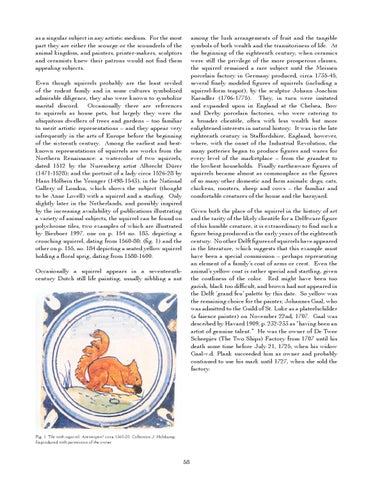among the lush arrangements of fruit and the tangible symbols of both wealth and the transitoriness of life. At the beginning of the eighteenth century, when ceramics were still the privilege of the more prosperous classes, the squirrel remained a rare subject until the Meissen porcelain factory in Germany produced, circa 1735-45, several finely modeled figures of squirrels (including a squirrel-form teapot), by the sculptor Johann Joachim Kaendler (1706-1775). They, in turn were imitated and expanded upon in England at the Chelsea, Bow and Derby porcelain factories, who were catering to a broader clientèle, often with less wealth but more enlightened interests in natural history. It was in the late eighteenth century in Staffordshire, England, however, where, with the onset of the Industrial Revolution, the many potteries began to produce figures and wares for every level of the marketplace – from the grandest to the lowliest households. Finally earthenware figures of squirrels became almost as commonplace as the figures of so many other domestic and farm animals: dogs, cats, chickens, roosters, sheep and cows – the familiar and comfortable creatures of the house and the barnyard.
as a singular subject in any artistic medium. For the most part they are either the scourge or the scoundrels of the animal kingdom, and painters, printer-makers, sculptors and ceramists knew their patrons would not find them appealing subjects. Even though squirrels probably are the least reviled of the rodent family and in some cultures symbolized admirable diligence, they also were known to symbolize marital discord. Occasionally there are references to squirrels as house pets, but largely they were the ubiquitous dwellers of trees and gardens – too familiar to merit artistic representations – and they appear very infrequently in the arts of Europe before the beginning of the sixteenth century. Among the earliest and bestknown representations of squirrels are works from the Northern Renaissance: a watercolor of two squirrels, dated 1512 by the Nuremberg artist Albrecht Dürer (1471-1528); and the portrait of a lady circa 1526-28 by Hans Holbein the Younger (1498-1543), in the National Gallery of London, which shows the subject (thought to be Anne Lovell) with a squirrel and a starling. Only slightly later in the Netherlands, and possibly inspired by the increasing availability of publications illustrating a variety of animal subjects, the squirrel can be found on polychrome tiles, two examples of which are illustrated by Biesboer 1997, one on p. 154 no. 183, depicting a crouching squirrel, dating from 1560-80; (fig. 1) and the other on p. 155, no. 184 depicting a seated yellow squirrel holding a floral sprig, dating from 1580-1600.
Given both the place of the squirrel in the history of art and the rarity of the likely clientèle for a Delftware figure of this humble creature, it is extraordinary to find such a figure being produced in the early years of the eighteenth century. No other Delft figures of squirrels have appeared in the literature, which suggests that this example must have been a special commission – perhaps representing an element of a family’s coat of arms or crest. Even the animal’s yellow coat is rather special and startling, given the costliness of the color. Red might have been too garish, black too difficult, and brown had not appeared in the Delft ‘grand feu’ palette by this date. So yellow was the remaining choice for the painter, Johannes Gaal, who was admitted to the Guild of St. Luke as a plateelschilder (a faience painter) on November 22nd, 1707. Gaal was described by Havard 1909, p. 232-233 as “having been an artist of genuine talent.” He was the owner of De Twee Scheepjes (The Two Ships) Factory from 1707 until his death some time before July 21, 1725, when his widow Gaal-v.d. Plank succeeded him as owner and probably continued to use his mark until 1727, when she sold the factory.
Occasionally a squirrel appears in a seventeenthcentury Dutch still life painting, usually nibbling a nut
Fig. 1. Tile with squirrel. Antwerpen? circa 1560-80. Collection J. Holtkamp. Reproduced with permission of the owner.
58
